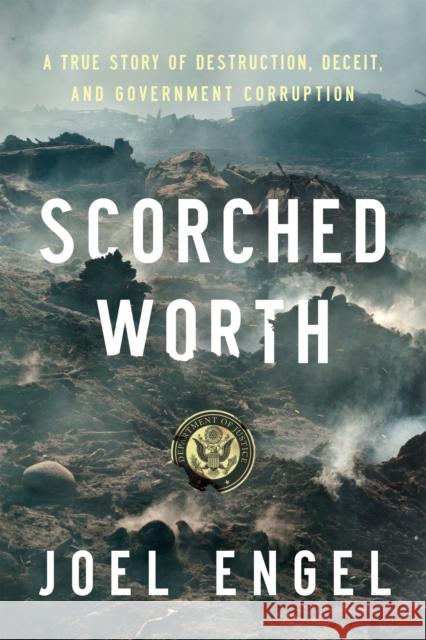Scorched Worth: A True Story of Destruction, Deceit, and Government Corruption » książka
topmenu
Scorched Worth: A True Story of Destruction, Deceit, and Government Corruption
ISBN-13: 9781594039812 / Angielski / Twarda / 2018 / 296 str.
The problems with America's criminal-justice system have been covered extensively in newspapers, magazines, and books. But little, if anything, has been written or said about a uniquely odious form of sanctioned corruption: government agencies maliciously suing individuals and companies. The motive is usually cost recovery. For the prosecuting lawyers, lawsuits that bring in money to the treasury (some of which gets kicked back to the prosecuting department) are a fast track to promotion and prestige. But the motive may also be personal--jealousy, envy, even a lawyer's warped sense of social justice.
More often than we suspect, these suits are perversions of justice. With unlimited budgets and the awesome power of the state behind them, government lawyers are unconstrained by either statute or case law that would compel them under penalty of sanctions or disbarment to drop unjust suits. True, there are established ethical standards to which they've sworn adherence, but in the real world the lawyers' own consciences are all that guide them. Not surprisingly, given their rank atop the hierarchy of law enforcement, the most egregious offenders are in the United States Department of Justice. Which brings us to our book, tentatively titled Corruption in the Moonlight: How the Department of Justice Became the Department of Revenue. In 2007, a forest fire broke out on Moonlight Peak in the Plumas National Forest of California's eastern Sierra Nevada, burning about 65,000 acres. An investigator from the California Department of Forestry (Cal Fire) and one from the United States Forest Service (USFS) conducted a perfunctory investigation and filed a report that blamed Sierra Pacific Industries, a successful forest-service products company, for the fire. The report claimed that SPI's independent logging contractor had started the conflagration by driving a bulldozer over a rock, creating a spark that flew into a pile of brush. SPI wouldn't know anything about this for two years, until the U.S. Department of Justice and California's attorney general filed separate but nearly identical suits against SPI. The amount being sought by the U.S. alone was nearly a billion dollars, though the value of the land, had it been disappeared off the earth instead of already undergoing a renaissance, was only about $20 million. In short, this was a civil death-penalty case, so of course the company fought hard with a team of smart, aggressive lawyers. Week by week, month by month, year by year, SPI's lawyers discovered that the investigators on whose findings the suit was based had falsified evidence to support their predetermination that SPI had been negligent. They had looked only for what they wanted to find and ignored an enormous body of evidence pointing toward, among other things, a young addict with psych issues who very well may have intentionally or accidentally started the fire. While the Assistant United States Attorney and the California Deputy Attorney General could not have known at the beginning that the investigation on which they'd based their suits was fictitious or fabricated, they refused to drop the suit as the discovery process continued and dozens of revelatory findings made clear how dishonest and malicious the investigation had been. Indeed, they doubled down, even to the point of conspiring with the investigators to devise answers to damning questions and lying (under penalty of perjury) on interrogatories. Shortly before trial, a U.S. district judge newly named to the bench ruled that it didn't matter whether SPI had started the fire; it could still be deemed negligent and held financially responsible. Now, SPI'S lawyers could not put the young man who may well have started the fire on the stand, and their scientific evidence proving that the fire (a) had not started where the government claimed it had, and (b) could not have been started in the way the government insisted it had might be interpreted by the jury as irrelevant. Naturally, this forced SPI to settle with the feds in what the government celebrated loudly as a landmark settlement. The risk of possibly losing a case that should've been dropped was too high: receivership and possible bankruptcy. So the company agreed to transfer 22,500 acres of land to the USFS and pay $50 million cash to the U.S. treasury. Now came the state of California's turn at bat. This time, though, there would be no ridiculous ruling to help the prosecutors. In fact, when the superior court judge read the pleadings and evidence for a pretrial hearing, he summarily tossed the case and issued the largest fine in U.S. history against a government entity for fraud and deceit. This helped confirm SPI's belief that the federal case would have been dropped long before in a DOJ headed by someone other than Eric Holder. (SPI is a successful lumber-products company that, according to favored constituencies, despoils the planet.) The book is a riveting narrative that begins with the fire, takes us through the flawed investigation (complete with Keystone Kops errors), and then into the most startling evidence and (deposition) testimony that, piece by piece, unraveled the government's case. By the time the reader gets to the federal judge's decision that forced SPI to deal, s/he will be shouting about injustice. And, in order that this injustice is deeply felt--as opposed to perpetrated on some faceless corporate victim--the book also serves as a mini biography of Aldis Archie "Red" Emmerson. The product of a Dickensian childhood during the Depression, Emmerson founded Sierra Pacific Industries in the 1950s and, with his own hands and grit and native smarts, built it into one of the country's most successful forest products companies. As the third largest private landowner in the U.S. (some two million acres of timberlands in California and Washington), he annually makes the Forbes and Fortune billionaires' l










